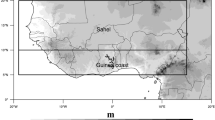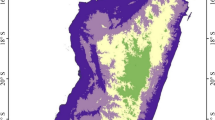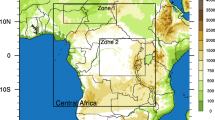Abstract
This study uses daily rainfall data from 20 global climate models (GCMs) simulations, participating in the phase 5 of the Coupled Model Intercomparison Project (CMIP5) and eight daily rainfall indices defined by the Expert Team on Climate Change Detection and Indices (ETCCDI), to investigate the changes in extreme weather conditions over Central Africa under the representative concentration pathway 8.5. The performance of the multi-model ensemble (MME) mean which in fact refers to the best performing models selected through the Taylor diagram analysis was evaluated by comparing with two gridded daily observation datasets during the historical period (1998–2005). Results show that although some uncertainties may exist between the gridded observation datasets, MME consistently outperform individual models and reasonably reproduced the observed pattern of daily rainfall indices over the region, except in the case of consecutive wet day (CWD) where the high variability of individual members has resulted in the degradation of the overall skill of the MME. The assessment of the climate change signal in the eight daily rainfall indices was done for the mid and late twenty-first century (2026–2056 and 2066–2095 respectively), relative to the baseline historical time period (1976–2005). We found a significant increase in the total wet day rainfall amount (PRCPTOT) over southern (northern) Central Africa from December to February (from September to November). This is mainly due to the increase of high intense rainfall events rather than their frequency. The results also reveal that the increase in PRCPTOT was coupled with increase in the maximum consecutive 5-day rainfall amount (RX5DAY), the 95th percentile (R95), and the total wet day rainfall amount above the 95th percentile (R95PTOT), with more robust patterns of change at the late twenty-first century. The increase in extreme rainfall events (RX5DAY, R95, and R95PTOT) is likely to increase flood risks over Cameroon, Central African Republic, Gabon, Congo, Angola, Zambia, and Democratic Republic of Congo. On the other hand, changes in CWD and PRCPTOT are projected to significantly decrease over Angola, Zambia, and Democratic Republic of Congo from September to November. This is due to a substantial increase of zonal moisture divergence fluxes in upper atmospheric layers. The analysis has also shown that areas where CWD and PRCPTOT decreases coincides with those where consecutive dry days (CDD) increase. The decrease in CWD and PRCPTOT coupled with the increase in CDD could worsen drought risk and significantly disrupt priority socio-economic sectors for development such as rain-fed agriculture, hydroelectric power generation, and water resource availability. The results thus underline the importance for decision-makers to seriously consider adaptation and mitigation measures, in order to limit the risks of natural disasters such as severe droughts and floods that Central African countries may suffer in the future.















Similar content being viewed by others
References
Abiodun BJ, Adegoke J, Abatan AA, Ibe CA, Egbebiyi TS, Engelbrecht F, Pinto I (2017) Potential impacts of climate change on extreme precipitation over four African coastal cities. Climatic Change 143:399–413. https://doi.org/10.1007/s10584-017-2001-5
Aguilar E, Barry AA, Brunet M, Ekang L, Fernandes A, Massoukina M, Mbah J, Mhanda A, do Nascimento D, Peterson T, Umba OT, Tomou M, Zhang X (2009) Changes in temperature and precipitation extremes in western central Africa, Guinea Conakry, and Zimbabwe, 1955-2006. J Geophys Res Atmos 114:D02,115. https://doi.org/10.1029/2008JD011010
Akinsanola AA, Zhou W (2018a) Ensemble-based CMIP5 simulations of West African summer monsoon rainfall: current climate and future changes. Theor Appl Climatol, pp 1–11, https://doi.org/10.1007/s00704-018-2516-3
Akinsanola AA, Zhou W (2018b) Projections of West African summer monsoon rainfall extremes from two CORDEX models. Clim Dyn, pp 1–12, https://doi.org/10.1007/s00382-018-4238-8
Akinsanola AA, Ogunjobi KO, Ajayi V, Adefisan EA, Omotosho JA, Sanogo S (2017) Comparison of five gridded precipitation products at climatological scales over West Africa. Meteorol Atmos Phys 129:669–689. https://doi.org/10.1007/s00703-016-0493-6
Almer C, Laurent-Lucchetti J, Oechslin M (2017) Water scarcity and rioting: disaggregated evidence from Sub-Saharan Africa. J Environ Econ Manag 86:193–209. https://doi.org/10.1016/j.jeem.2017.06.002
Aloysius NR, Saiers JE (2017) Simulated hydrologic response to projected changes in precipitation and temperature in the Congo River basin. Hydrol Earth Syst Sci 21:4115–4130. https://doi.org/10.5194/hess-21-4115-2017
Aloysius NR, Sheffield J, Saiers JE, Li H, Wood EF (2016) Evaluation of historical and future simulations of precipitation and temperature in central Africa from CMIP5 climate models. J Geophys Res Atmos 121:130–152. https://doi.org/10.1002/2015JD023656
Alsdorf D, Beighley E, Laraque A, Lee H, Tshimanga R, O’Loughlin F, Mahé G, Dinga B, Moukandi G, Spencer RGM (2016) Simulated hydrologic response to projected changes in precipitation and temperature in the Congo River basin. Hydrol Earth Syst Sci 21:4115–4130. https://doi.org/10.5194/hess-21-4115-2017
Bellucci A, Gualdi S, Navarra A (2010) The double-ITCZ syndrome in coupled general circulation models: the role of large-scale vertical circulation regimes. J Clim 23:1127–1145. https://doi.org/10.1175/2009JCLI3002.1
Chamani R, Monkam D, Djomou ZY (2018) Analysis of return periods and return levels of yearly July-September extreme droughts in the West African Sahel. Clim Dyn, pp 1–13, https://doi.org/10.1007/s00382-018-4336-7
Collins M, Knutti R, Arblaster J, Dufresne JL, Fichefet T, Friedlingstein P, Gao X, Gutowski W, Johns T, Krinner G, Shongwe M, Tebaldi C, Weaver A, Wehner M (2013) Long-term climate change: projections, commitments and irreversibility. In: Stocker TF, Qin D, Plattner G-K, Tignor M., Allen SK, Boschung J, Nauels A, Xia Y, Bex V, Midgley PM (eds) Climate change 2013: the physical science basis. Contribution of working group I to the fifth assessment report of the intergovernmental panel on climate change. United Kingdom and New York, NY, USA. Cambridge University Press, Cambridge
Déqué M, Calmanti S, Christensen OB, Aquila AD, Maule CF, Haensler A, Nikulin G, Teichmann C (2017) A multi-model climate response over tropical Africa at + 2°C. Clim Serv 7:87–95. https://doi.org/10.1016/j.cliser.2016.06.002
Diallo I, Giorgi F, Deme A, Tall M, Mariotti L, Gaye AT (2016) Projected changes of summer monsoon extremes and hydroclimatic regimes over West Africa for the twenty-first century. Clim Dyn 47:3931–3954. https://doi.org/10.1007/s00382-016-3052-4
Dyer ELE, Jones DBA, Nusbaumer J, Li H, Collins O, Vettoretti G, Noone D (2017) Congo Basin precipitation: assessing seasonality, regional interactions, and sources of moisture. J Geophys Res Atmos 122:6882–6898. https://doi.org/10.1002/2016JD026240
FAO (2018). FAO in emergencies. http://www.fao.org/emergencies/regions/east-and-central-africa/en/, (accessed 14 November 2018)
Fauchereau N, Trzaska S, Rouault M, Richard Y (2003) Rainfall variability and changes in southern africa during the 20th century in the global warming context. Nat Hazards 29:139– 154
Fotso-Nguemo TC, Vondou DA, Pokam WM, Djomou ZY, Diallo I, Haensler A, Tchotchou LAD, Kamsu-Tamo PH, Gaye AT, Tchawoua C (2017) On the added value of the regional climate model REMO in the assessment of climate change signal over Central Africa. Clim Dyn 49:3813–3838. https://doi.org/10.1007/s00382-017-3547-7
Fotso-Nguemo TC, Chamani R, Yepdo ZD, Sonkoué D, Matsaguim CN, Vondou DA, Tanessong RS (2018) Projected trends of extreme rainfall events from CMIP5 models over Central Africa. Atmos Sci Lett 19:1–8. https://doi.org/10.1002/asl.803
Haensler A, Saeed F, Jacob D (2013) Assessing the robustness of projected precipitation changes over central Africa on the basis of a multitude of global and regional climate projections. Clim Change 121:349–363. https://doi.org/10.1007/s10584-013-0863-8
Huffman GJ, Adler RF, David TB, Guojun G (2009) Improving the global precipitation record: GPCP Version 2.1. Geophys Res Lett 36(L17):808. https://doi.org/10.1029/2009GL040000
Huffman GJ, Adler RF, Bolvin DT, Nelkin EJ (2010) The TRMM Multi-satellite Precipitation Analysis (TMPA). In: Hossain F, Gebremichael M (eds) Satellite applications for surface hydrology. ISBN: 978-90-481-2914-0. Springer, Berlin, pp 3–22
IPCC (2013) Summary for policymakers. In: Climate change 2013: The physical science basis contribution of working group I to the fifth assessment report of the intergovernmental panel on climate change. United Kingdom and New York, NY, USA. Cambridge University Press, Cambridge
Kitoh A, Endo H, Kumar KK, Cavalcanti IF, Goswami P, Zhou T (2013) Monsoons in a changing world: a regional perspective in a global context. J Geophys Res Atmos 118:3053–3065. https://doi.org/10.1002/jgrd.50258
Knutti R, Furrer R, Tebaldi C, Cermak J, Meehl GA (2010) Challenges in combining projections from multiple climate models. J Clim 23:2739–2758
Krishnamurti TN, Kishtawal CM, Zhang Z, Larow T, Bachiochi D, Willford E (2000) Multimodel ensemble forecasts for weather and seasonal climate. J Climate 13:4196–4216
Kruger A (2006) Observed trends in daily precipitation indices in South Africa: 1910-2004. Int J Climatol 26:2275–2285
Li G, Xie S (2014) Tropical biases in CMIP5 multimodel ensemble: the excessive equatorial Pacific cold tongue and double ITCZ problems. J Clim 27:1765–1780
Libanda B, Ngonga C (2018) Projection of frequency and intensity of extreme precipitation in Zambia: a CMIP5 study. Clim Res 76:59–72
Nikulin G, Jones C, Samuelsson P, Giorgi F, Asrar G, Büchner M, Cerezo-Mota R, Christensen OB, Déqué M, Fernandez J, Hänsler A, van Meijgaard E, Sylla MB, Sushama L (2012) Precipitation climatology in an ensemble of CORDEX-africa regional climate simulations. J Clim 25:6057–6078. https://doi.org/10.1175/JCLI-D-11-00375.1
Nikulin G, Lennard C, Dosio A, Kjellström E, Chen Y, Hänsler A, Kupiainen M, Laprise R, Mariotti L, Maule CF, van Meijgaard E, Panitz HJ, Scinocca JF, Somot S (2018) The effects of 1.5 and 2 degrees of global warming on Africa in the CORDEX ensemble. Environ Res Lett 13:1–19. https://doi.org/10.1088/1748-9326/aab1b1
Odoulami RC, Akinsanola AA (2017) Recent assessment of West African summer monsoon daily rainfall trends. Weather 99:1–4. https://doi.org/10.1002/wea.2965
Phillips TJ, Gleckler PJ (2006) Evaluation of continental precipitation in 20th century climate simulations: the utility of multimodel statistics. Water Resour Res 42:W03,202. https://doi.org/10.1029/2005WR004313
Pokam MW, Longandjo GN, Moufouma-Okia W, Bell JP, James R, Vondou DA, Haensler A, Fotso-Nguemo TC, Guenang GM, Tchotchou ALD, Kamsu-Tamo PH, Takong RR, Nikulin G, Lennard CJ, Dosio A (2018a) Consequences of 1.5°C and 2°C global warming levels for temperature and precipitation changes over Central Africa. Environ Res Lett 13:1–12. https://doi.org/10.1088/1748-9326/aab048
Pokam MW, Yontchang GD, Kamsu-Tamo PH, Kabengela H, Igri M, Tanessong R, Vondou DA, Guenang GM (2018b) Pathway of developing sub-seasonal to seasonal seamless prediction for disaster risk management over Central Africa. S2S News Lett 9:4–7
Saha F (2015) Les changements climatiques et la vulnerabilité des villes d’Afrique centrale aux risques naturels : cas des inondations et des mouvements de masse à Bamenda (nord-ouest du Cameroun). Edilivre-aparis, Classique, pp 206́
Sonwa DJ, Somorin OA, Jum C, Bele MY, Nkem JN (2012) Vulnerability, forest-related sectors and climate change adaptation: the case of Cameroon. For Policy Econ 23:1–9
Sylla MB, Giorgi F, Coppola E, Mariotti L (2013) Uncertainties in daily rainfall over Africa: assessment of observation products and evaluation of a regional climate model simulation. Int J Climatol 33:1805–1817. https://doi.org/10.1002/joc.3551
Sylla MB, Giorgi F, Pal JS, Gibba P, Kebe I, Nikiema M (2015) Projected changes in the annual cycle of high-intensity precipitation events over West Africa for the late twenty-first century. J Clim 28:6475–6488. https://doi.org/10.1175/JCLI-D-14-00854.1
Tamoffo AT, Moufouma-Okia W, Pokam WM, Guenang GM, Vondou DA, Dosio A, Longandjo GN, Lennard CJ, Fotso-Nguemo TC, Nikulin G, Bell JP, Takong RR, James R, Haensler A, Tchotchou LAD, Kamsu-Tamo PH, Nouayou R (2018) Impacts of 1.5°C and 2°C global warming on moisture transport in the Central African region. Clim Dyn p Under Review
Tanessong RS, Vondou DA, Djomou ZY, Igri PM (2017) WRF High resolution simulation of an extreme rainfall event over Douala(Cameroon): a case study. Model Earth Syst Environ 3:927–942. https://doi.org/10.1007/s40808-017-0343-7
Taylor KE (2001) Summarizing multiple aspects of model performance in a single diagram. J Geophys Res 106:7183–7192
Trenberth KE (2011) Changes in precipitation with climate change. Clim Res 47:123–138
Vizy E, Cook KH (2012) Mid-twenty-first-century changes in extreme events over northern and tropical Africa. J Clim 25:5748–5767
Zogning A, Ngouanet C, Ojuku T (2007) The catastrophic geomorphological processes in humid tropical Africa: a case study of the recent landslide disasters in Cameroon. Sediment Geol 199:13– 17
Acknowledgements
The authors would like to thank the climate modeling groups listed in Table 1, for producing and making available their model output through the website https://climate4impact.eu/impactportal/data/esgfsearch.jsp. The Global Precipitation Climatology Project and the Tropical Rainfall Measurement Mission are also acknowledged for providing the gridded datasets used in this study. We gratefully acknowledge the efforts of the two anonymous reviewers whose comments and suggestions substantially improved the first version of the manuscript.
Author information
Authors and Affiliations
Corresponding author
Additional information
Publisher’s Note
Springer Nature remains neutral with regard to jurisdictional claims in published maps and institutional affiliations.
Rights and permissions
About this article
Cite this article
Sonkoué, D., Monkam, D., Fotso-Nguemo, T.C. et al. Evaluation and projected changes in daily rainfall characteristics over Central Africa based on a multi-model ensemble mean of CMIP5 simulations. Theor Appl Climatol 137, 2167–2186 (2019). https://doi.org/10.1007/s00704-018-2729-5
Received:
Accepted:
Published:
Issue Date:
DOI: https://doi.org/10.1007/s00704-018-2729-5




